 Osaka, Japan – Thursday, June 16th, 2011
Osaka, Japan – Thursday, June 16th, 2011
 After two days in Fukuoka, I used my JR Rail pass to travel north to Osaka for the next four days. The first day had some rain in the forecast, which didn’t deter me from going to Universal Studios Japan, with most of its rides either enclosed or water-based. Rain was off-and-on throughout the day, but given the lower crowds I probably couldn’t have asked
After two days in Fukuoka, I used my JR Rail pass to travel north to Osaka for the next four days. The first day had some rain in the forecast, which didn’t deter me from going to Universal Studios Japan, with most of its rides either enclosed or water-based. Rain was off-and-on throughout the day, but given the lower crowds I probably couldn’t have asked for a better experience.
for a better experience.
If I had to pick one single park to call the best of the Universal parks, it would probably be Universal Studios Japan. It’s an uber-park combining all the best attractions found between the two parks in Florida within a single gate. Not only that, but despite opening relatively recently in 2001, it’s become a repository of many of Universal’s best classic attractions, with Back to the Future: The Ride sending visitors into futuristic Hill Valley 2015 as of my visit in 2011 (and even as recently as 2016!), and still hosting the last remaining Jaws, T2:3D, and Backdraft attractions as of this writing in 2020. And it looks like the park has only continued to drastically improve since then, adding a major Jurassic Park flying coaster, what looks to be the best version of the Wizarding World Hogsmeade, and now the world debut of Super Nintendo World.
this writing in 2020. And it looks like the park has only continued to drastically improve since then, adding a major Jurassic Park flying coaster, what looks to be the best version of the Wizarding World Hogsmeade, and now the world debut of Super Nintendo World.
It’s also unmistakably a Universal Studios park, even if you don’t ride anything. The park is mostly defined by facades everywhere, with a water feature anchoring the center of the park and the landscape design generally average to poor throughout. Because virtually every attraction you come across is (or at least advertises itself like it is) a top-tier “E-ticket” style experience, with relatively few filler attractions (and even fewer outdoor attractions), most of the time spent in the park is going to be inside the show buildings,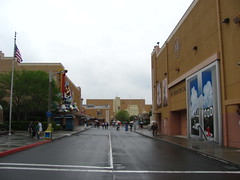 or maybe outside watching a parade. There’s relatively little incentive to wander the walkways. Which is fine. I’d rather parks focus their energies exclusively on what they do well, as it tends to lead to both better and more differentiated parks.
or maybe outside watching a parade. There’s relatively little incentive to wander the walkways. Which is fine. I’d rather parks focus their energies exclusively on what they do well, as it tends to lead to both better and more differentiated parks.
Where you do see Osaka deviate from the Universal model is in the selection of some of the more recent IP. Opening with all the standard action or disaster movies starring male leads, Universal quickly realized that in Japan it’s generally young women who lead the decision-making for recreational activities like going to a theme park with their friends/boyfriend/husband/families. Thus, the park has since been steadily receiving an injection of kawaii cuteness, by way of licensed IP (Hello Kitty, Snoopy, or Sesame Street) or their own original designs (Hollywood Dream or Space Fantasy; both also thrill rides, no less). The results speak for themselves, with Universal Studios Japan going from a weak launch in 2001 to now the most-attended Universal theme park globally.
or their own original designs (Hollywood Dream or Space Fantasy; both also thrill rides, no less). The results speak for themselves, with Universal Studios Japan going from a weak launch in 2001 to now the most-attended Universal theme park globally.
In the end you get a Universal park that pretty much has everything a visitor from abroad could ask for. Most of the favorite Universal Studios attractions, including a few last-of-their-kind classics, but mixed with enough local flavor to justify the trip halfway around the world (as opposed to halfway across Florida). I don’t consider myself a particularly big fan of Universal parks in general, but if there’s one park that I felt deserved to represent the chain on my list of Very Good Parks, it’s this one.
If the standard of judgement is compared against Hollywood Rip, Ride, Rockit, then of course Hollywood Dream is pretty good. Efficient, smooth, and ditches the lame music posers in favor of a more sincere (if effeminate) Japanese interpretation of the appeal of Hollywood. Universal parks fans will be pleased by the higher standard of quality and presentation taken by this relatively “unthemed” coaster.
If the standard of judgement is compared against virtually any other B&M mega-coaster, then of course Hollywood Dream is pretty mediocre. Short, slow, mild-to-nonexistent forces, and an awkwardly shoehorned layout above and between preexisting buildings in a space clearly never intended for a large coaster, putting even more limitations on an already limited ride. Coaster enthusiasts will be annoyed by seeing all the extra fluff attached to a ride that still misses so many of the basics of a good coaster.
If the standard of judgement is simply all the attractions at Universal Studios Japan, then it does alright. Big, urban studio-style theme parks can often feel like a never-ending procession of static facades hiding exciting but never-seen rides, so putting a kinetic roller coaster up front, especially one that does try its best to compliment the existing architecture (rather than just blast through it à la Hollywood Rockit) was a wise move. The generic but aspirational Hollywood theme serves as a pleasant thesis statement to introduce the rest of the park, and telegraphs to visitors even if they don’t choose to ride that they’ve arrived at a place designed to be dynamic and fun. Plus, with so much else in this park based on screens and motion bases, having an uncomplicated outdoor roller coaster as the first and last attraction of the day is a welcome contrast. And it’s still a B&M mega coaster, which as of my visit in 2011 was the only one built in Asia. Of course it’s good. But far from great.
Space Fantasy The Ride
 NOW we’re talking about a great coaster, and a great Universal attraction! An indoor spinning coaster supplied by Mack Rides in 2010, Space Fantasy is still to date the last major Universal attraction built with an original IP (excluding any water slides). Free from the constraints of preexisting media, Space Fantasy tailors its message to fit its medium in a way uniquely tailored for a theme park setting as a blacklit fantasia in outer space.
NOW we’re talking about a great coaster, and a great Universal attraction! An indoor spinning coaster supplied by Mack Rides in 2010, Space Fantasy is still to date the last major Universal attraction built with an original IP (excluding any water slides). Free from the constraints of preexisting media, Space Fantasy tailors its message to fit its medium in a way uniquely tailored for a theme park setting as a blacklit fantasia in outer space.
The storyline perfectly dates itself to the (now nostalgic) late-aughts/early-teens vogue of techno-utopianism, especially evidenced from the Apple-style smartbot and Nintendo-esque princess sending us on an mission to reignite the fading sun, an act of social and environmental do-good heroism that underpins the ride’s urgent yet refreshingly uncomplicated spirit of affirmation. (No villains or monsters here!)
The coaster experience itself perfectly strikes the balance of exciting thrills with a positive sense of wonder that one is always eager to see what’s next, whether its flying through a rainbow LED warp tunnel, spinning amidst a twinkling star field, or entering the sun itself for a phosphorescent finale inside a Yayoi Kusama-inspired infinity mirror room, strobing with retina-searing intensity. The art direction is more involved than the abstract minimalism of Space Mountain but not quite yet at the digital-everythingness of TRON Lightcycles Power Run; Space Fantasy uses a suite of both traditional and modern dark ride effects however they’ll be most effective, less directed by the need for a specific representation, but rather in the free spirit of artistic interpretations of space flight. It’s hard to imagine many IPs that would allow for that degree of creative flexibility in design, other than perhaps… The Moody Blues?
With a fast-moving queue rarely more than five minutes long and a day that constantly threatened rain, I spent most of my afternoon riding Space Fantasy at least ten times, as it was quite possibly the best theme park attraction I had encountered across my Asian travels thus far. With the forward-and-back seating mixed with the random spinning through show-scenes, there was always something new to discover with every ride, a quality of instant re-rideability that I usually find lacking from Universal’s more narrative-heavy major attractions. Sadly, Space Fantasy has since been repurposed as a semi-permanent VR/XR attraction as part of the Universal Cool Japan event incorporating various Japanese brands and media franchises. The idea is good in theory (more locally-specific flexibility is always good), but it also seems to be a waste of so much of Space Fantasy’s best assets, from the elaborate indoor sets even down to the spinning, back-to-back seats that have to be kept locked and only assigned to forward-facing positions to make any spatial sense in VR. Apparently the original Space Fantasy does return from time-to-time, so if I ever make my way back to Universal Studios Japan, I’ll try my best to schedule it during one of those windows before the ride bows out entirely. Universal doesn’t have the best track record of respecting its classics, and Space Fantasy The Ride surely ranks among the top tier of modern classics of themed thrill ride experiences.
Terminator 2: 3D
 There’s a lot words to be said about Gary Goddard, but if there’s one thing to his credit it’s that the Universal attractions that Landmark Entertainment Group was involved with tended to be among the best examples of the “golden age” of Universal Studios, T2 3-D included. Technically it’s just a live show based on a movie, but it certainly feels like more than “just a show,” and the set-up is clever enough that it doesn’t feel like it’s simply aping its beats from the Jim Cameron movies, even if it still delivers on virtually everything you’d expect of a Terminator movie. With both stateside installations now gone, hopefully this last remaining example in Japan stays going for a while longer. Yes, it’s a bit more confusing if you don’t speak Japanese, but the audience interaction during the pre-show can still be fun for foreigners. Rather conspicuously sticking out amongst the audience, the Cyberdyne host quickly noticed and called upon me in English to ask where I was from, and upon hearing my response she emphatically repeated “Amerika-desu!” for the entire crowd to politely applaud me. Thus was how my 15 seconds of fame went at Universal Studios Japan.
There’s a lot words to be said about Gary Goddard, but if there’s one thing to his credit it’s that the Universal attractions that Landmark Entertainment Group was involved with tended to be among the best examples of the “golden age” of Universal Studios, T2 3-D included. Technically it’s just a live show based on a movie, but it certainly feels like more than “just a show,” and the set-up is clever enough that it doesn’t feel like it’s simply aping its beats from the Jim Cameron movies, even if it still delivers on virtually everything you’d expect of a Terminator movie. With both stateside installations now gone, hopefully this last remaining example in Japan stays going for a while longer. Yes, it’s a bit more confusing if you don’t speak Japanese, but the audience interaction during the pre-show can still be fun for foreigners. Rather conspicuously sticking out amongst the audience, the Cyberdyne host quickly noticed and called upon me in English to ask where I was from, and upon hearing my response she emphatically repeated “Amerika-desu!” for the entire crowd to politely applaud me. Thus was how my 15 seconds of fame went at Universal Studios Japan.
The Amazing Adventures of Spider-Man
 This was my first time ever on a Spider-Man attraction. Despite the queue theming being rendered all in English, once on the ride I didn’t have the benefit of understanding all the nuances of the plot as conveyed though spoken dialogue. But as the experience progressed I was able to figure out that it wasn’t a huge loss. The popular opinion seems to be that The Amazing Adventures of Spider-Man is a better ride than Transformers and one of the best dark rides in the world, and while I’ll agree to the former point I’m not so convinced on the latter point.
This was my first time ever on a Spider-Man attraction. Despite the queue theming being rendered all in English, once on the ride I didn’t have the benefit of understanding all the nuances of the plot as conveyed though spoken dialogue. But as the experience progressed I was able to figure out that it wasn’t a huge loss. The popular opinion seems to be that The Amazing Adventures of Spider-Man is a better ride than Transformers and one of the best dark rides in the world, and while I’ll agree to the former point I’m not so convinced on the latter point.
It doesn’t require an understanding of Japanese to sense that the storyline isn’t particularly well-paced, with a single talky expository scene with Spider-Man before you’re subjected to the “Villains Special-Effects Slideshow” for more than half the ridetime, a steady procession of largely standalone gags ranging from the good (Hobgoblin’s exploding fireball bridge) to the poor (Scream making faces at you in 3D) to the “Universal On-Brand” (Hydro-Man triggering the mandatory water-spritz). It doesn’t start to gel as a story until you get to the anti-gravity scenes at the finale, but it’s become such an over-used trope for media-based dark rides (largely due to this ride’s success) that it doesn’t have the same emotional impact I’m sure it did the year it opened. Or maybe I’m just a crank.
Back to the Future: The Ride
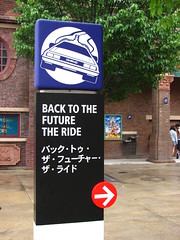 Looking back, there’s a part of me that regrets only riding Back to the Future: The Ride once on this day. In 2011 the ride had already been long-gone from the stateside parks and, with its date-specific time travel getting closer and closer to out-dating itself (which it finally did in 2016), was clearly a top contender for this last iteration to be removed from Japan as well, making it more urgent that I get my rides in while I still could. Plus, out of any of the park’s attractions, Back to the Future was the one Universal property I had the closest connection to when I was younger.
Looking back, there’s a part of me that regrets only riding Back to the Future: The Ride once on this day. In 2011 the ride had already been long-gone from the stateside parks and, with its date-specific time travel getting closer and closer to out-dating itself (which it finally did in 2016), was clearly a top contender for this last iteration to be removed from Japan as well, making it more urgent that I get my rides in while I still could. Plus, out of any of the park’s attractions, Back to the Future was the one Universal property I had the closest connection to when I was younger.
But then I remember what my actual experience that day was like, and why at the time I set my priorities elsewhere (mainly re-riding Space Fantasy). It’s a very dialogue-heavy attraction, with an endless series of increasingly claustrophobic preshows that can leave one feeling anxious especially if it’s hard to follow what’s happening on-screens due to language differences. Then there’s the ride itself, which as a motion-simulator using relatively primitive techniques was prone to leaving me with a light sensation of nausea by the end. Sure, it was tons of nostalgic fun in the moment, and with a surprising degree of lateral content that’s rare from modern movie-based attractions. (Of course if you have a time machine you should go see some dinosaurs, but that’s a huge departure from the movies which always stayed relatively local within the space-time continuum as a means to a story about familial histories.) But once I had the satisfaction of finally getting that experience checked off and behind me, it doesn’t surprise me that I didn’t feel the need to have it again a few hours later.
I’d also like to note that, while The Simpsons Ride is possibly one of the better examples of a successful attraction re-theme, it still highlights a fundamental problem of re-themed attractions where once-specific design elements lose their original purpose and necessity. The ride vehicles for Back to the Future were so perfect, with the DeLorean’s gull wing safety doors and the stationary rear extension creating the detailed appearance of a flux capacitor as you entered. Those elements are still on the re-designed ride, but as a Krusty coaster car the doors and rear extension lose all their original significance and become unnecessary ornamentation. Experiencing good design is about understanding that everything has a purpose. With so many Universal and Disney attractions going this re-purposed route, I fear there may soon be the day where so much of the elegance of these theme parks as originally designed, even if it was in service of an outdated or misguided concept, has been replaced with newer, brighter, but fundamentally less purposeful design; design that’s less about final effect and more about trying to cover its tracks. That’s when a time-traveling DeLorean might really come in use.
Backdraft
 I’ll be perfectly honest. I forgot this attraction exists at Universal Studios Japan. I forgot this attraction ever existed at all at the Universal parks. I forgot this was ever a poorly-reviewed Ron Howard movie with Kurt Russell. I certainly forgot if I ever experienced this attraction at Universal Studios Japan first-hand. Yet I have a couple of photos apparently taken from inside the queue, so, unless for some reason the attraction suddenly closed before I could get inside, I’ll assume I did it. What follows is my reaction after watching a video online of Backdraft at USJ to refresh my memory.
I’ll be perfectly honest. I forgot this attraction exists at Universal Studios Japan. I forgot this attraction ever existed at all at the Universal parks. I forgot this was ever a poorly-reviewed Ron Howard movie with Kurt Russell. I certainly forgot if I ever experienced this attraction at Universal Studios Japan first-hand. Yet I have a couple of photos apparently taken from inside the queue, so, unless for some reason the attraction suddenly closed before I could get inside, I’ll assume I did it. What follows is my reaction after watching a video online of Backdraft at USJ to refresh my memory.
Nope, still not familiar! It does kinda make me nostalgic for the days when a big blockbuster movie just had to pick a disaster theme and then have characters deal with variations on said theme while managing some low-level romance and/or drama between scenes. But then they ran out of real disasters and had to put snakes on a plane or invent Sharknados, all while sexless superheroes gradually took over the entire media landscape anyway, and that was the end of that trend. Anyway, fire is good on a theme park attractions because most people do retain an innate fear of large open fires, and unlike most everything else at theme parks where you always know the danger is simulated, we still have a hard time believing and trusting that gigantic fireballs are really as controlled as the engineers thought they are. (Clearly this is going to be the show where it gets a little too out of control and someone’s eyebrows are singed!) But man, this attraction is literally nothing but a progression of increasingly nonsensical fire effects in the most generically nondescript industrial setting imaginable. At least stuff like Earthquake, Twister, or the Lights Camera Action shows had multiple different effects going on in somewhat distinctive settings, and sometimes (not often) even offer an element that produces a brief encounter with a second emotion such as humor or suspense. In fact, the slight agitation I now feel over how intentionally forgettable this attraction was seemingly designed to be is what’s starting to trigger a few of my synapses that makes me pretty sure I did experience Backdraft at some point in my life after all. (A ringing endorsement if ever there was one.)
Jurassic Park: The Ride
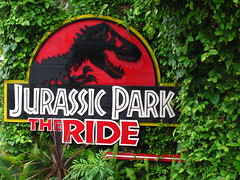 Jurassic Park: The Ride will always be the ultimate Universal Studios attraction. The only thing that comes close is Space Fantasy, which perhaps levels the playing field somewhat at Universal Studios Japan given that their version of Jurassic Park is arguably the weakest of the three made (not counting Singapore’s variant); the landscaping and scenic design feel slightly more value-engineered at this location, which can never quite fully convince one of having left Osaka behind.
Jurassic Park: The Ride will always be the ultimate Universal Studios attraction. The only thing that comes close is Space Fantasy, which perhaps levels the playing field somewhat at Universal Studios Japan given that their version of Jurassic Park is arguably the weakest of the three made (not counting Singapore’s variant); the landscaping and scenic design feel slightly more value-engineered at this location, which can never quite fully convince one of having left Osaka behind.
Otherwise the carefully controlled pacing that makes this attraction so stellar is still there, starting with unhurried wonderment that gives way to a slowly ratcheting terror before a thrilling finale that lives up to all the promises the ride ever made. The design is closest to Orlando’s while the setting, as a standalone “The Ride” in a studios-style park, feels closer to Hollywood’s original version. Despite having those versions closer to home, I still made sure to ride this one a couple times today.
Waterworld
 My second time at a Waterworld stunt show after Singapore. Much the same, but in Japanese. It is of course a very good show, with the right mix of stunts, action, comedy, big explosive effects, and… water gags. The fact that it’s based on a famous box office bomb is often held up as an example of how theme parks can stand separate from the movies they’re based on, creating a good attraction that can stand the test of time apart from the source IP that was quickly forgotten.
My second time at a Waterworld stunt show after Singapore. Much the same, but in Japanese. It is of course a very good show, with the right mix of stunts, action, comedy, big explosive effects, and… water gags. The fact that it’s based on a famous box office bomb is often held up as an example of how theme parks can stand separate from the movies they’re based on, creating a good attraction that can stand the test of time apart from the source IP that was quickly forgotten.
Yet I can’t help but feel like that’s a bit of a cop-out. If the elements that made Waterworld successful had nothing to do with the movie, then surely it wouldn’t be hard to divorce itself from the film entirely and apply the same successful formula to a more popular property or an original concept that wouldn’t be held back by Kevin Costner’s increasingly outdated conception of global warming as a launching point for swashbuckling entertainment. That Waterworld still plays in Hollywood is a testament to that original production’s legacy and connection to audiences in that particular location. But that the “Live Sea War Spectacular” was re-created in Osaka in 2001, then Singapore in 2010, and now Beijing in 2021… it’s less the mark of a timeless classic being reborn and more the mark of executives who have little confidence in the talent of their creatives, and no appetite for the risk of creating something new.
Jaws
 This is the Universal Studios equivalent of Disney’s Jungle Cruise as a slightly corny classic. Being chased around a vacant fishing village by an aggro fish through increasingly improbable encounters with randomly combustible materials in the water (including said fish itself) has a certain zany charm that I wish modern attractions could retain without becoming mind-numbingly stupid. (ahem-fast-n-furious-ahem.) While in some ways Jaws checks the boxes of a classic “ride the movies” attractions, in other ways I was surprised by how uniquely weird this ride is.
This is the Universal Studios equivalent of Disney’s Jungle Cruise as a slightly corny classic. Being chased around a vacant fishing village by an aggro fish through increasingly improbable encounters with randomly combustible materials in the water (including said fish itself) has a certain zany charm that I wish modern attractions could retain without becoming mind-numbingly stupid. (ahem-fast-n-furious-ahem.) While in some ways Jaws checks the boxes of a classic “ride the movies” attractions, in other ways I was surprised by how uniquely weird this ride is.
For starters, instead of the usual narrow winding river channels used on Jungle Cruise or other water-based themed attractions to control the sightlines and create a steady progression of scenic reveals, Jaws takes place over a couple of very broad, agoraphobic bodies of water that have the effect of seemingly spoiling all the upcoming surprises. On most rides of this type your eye is trained to scan for hidden corners where the next event is probably going to happen, but Jaws upends this by creating what feels like an open world (including a brief claustrophobic tunnel segment for contrast), even if the path is fixed. Of course, the real surprise is quickly revealed that the water itself is the hiding place where a giant robotic shark can lunge at close proximity without forewarning, the effect of which is effectively unsettling.
Jaws is also unconventional for a theme park attraction in as much as the action revolves around only a single threat that follows riders from beginning to end. Usually on a theme park attraction the danger would be more situational (i.e. there’s a group of sharks, or dinos, or super-villains, or whatever that are all happening at once because there’s a bigger situation happening that you’ve found yourself in), but Jaws is the story of a lone predator interrupting what would otherwise be an uneventful boat tour, repeating the same fishy encounter with new variations each time. It gives the attraction a steady, minimalist logic as it drives towards its ultimate conclusion when Jaws decides to take a break from biting humans to chomp on an underwater electrical cable, thus sealing his toothy fate. Although in my particular case, as I leaned over to get a good look at the fish fry once the danger was seemingly defeated, a rogue cross-wave managed to perfectly launch a splash of water directly into my face, and only my face. As we disembarked our skipper seemed surprised and sympathetic that somehow the foreigner was the only one on her ship targeted for a deep facial cleanse.
Snoopy Studios
 An indoor children’s area featuring Snoopy’s Great Race, a Japanese-made Senyo Kogyo interpretation of a Vekoma junior coaster. For American visitors it might feel a bit odd encountering Snoopy in a Universal park, given the character’s close association with Cedar Fair in the U.S. It’s also not neccesarily an upgrade in quality over the Cedar Fair versions, which at least generally manage a somewhat charming rustic appearance that befits the nostalgic leanings of the Charles Schultz comic. Here you get a dark, dingy indoor environment populated with flat scenic panels in cloying colors and an out-of-place and over-used studio theme that has very little to do with the original characters or stories. As a cute cartoon animal, Snoopy is tremendously popular in Japan and was a huge licensing score for Universal, but this particular zone feels like a missed opportunity. Especially with the Flight of the Hippogriff now making the junior coaster redundant, I wouldn’t mind seeing this area completely gutted and re-imagined with the Peanuts from fresh. But hey, for now it’s an extra credit.
An indoor children’s area featuring Snoopy’s Great Race, a Japanese-made Senyo Kogyo interpretation of a Vekoma junior coaster. For American visitors it might feel a bit odd encountering Snoopy in a Universal park, given the character’s close association with Cedar Fair in the U.S. It’s also not neccesarily an upgrade in quality over the Cedar Fair versions, which at least generally manage a somewhat charming rustic appearance that befits the nostalgic leanings of the Charles Schultz comic. Here you get a dark, dingy indoor environment populated with flat scenic panels in cloying colors and an out-of-place and over-used studio theme that has very little to do with the original characters or stories. As a cute cartoon animal, Snoopy is tremendously popular in Japan and was a huge licensing score for Universal, but this particular zone feels like a missed opportunity. Especially with the Flight of the Hippogriff now making the junior coaster redundant, I wouldn’t mind seeing this area completely gutted and re-imagined with the Peanuts from fresh. But hey, for now it’s an extra credit.
Conclusion
As a Thursday in the off-season, Universal Studios Japan wasn’t open very late, and with the skies getting progressively wetter as the sun sank lower it was soon time to make my way to the exit. It was still early so I didn’t bother finding dinner at Universal CityWalk (which probably would have been outside my price range regardless), so I headed back to the hostel.
I met a fellow traveler from Hong Kong, and he heard of an interesting food hall in Osaka which we decided to check out together. I forget exactly the establishment we ended up at, as we discovered the menu was entirely in Japanese. I could phonetically pronounce the hiragana and katakana scripts, while my friend could understand the meaning of the kanji characters (which are just borrowed from Chinese script). His ability turned out to be more useful, and we were soon served a delicious and reasonably priced Japanese meal.
All-in-all a very successful first day in Osaka!




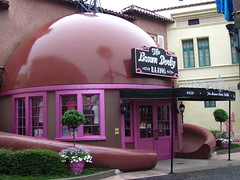
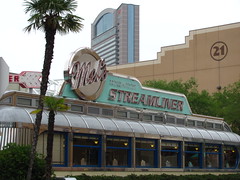











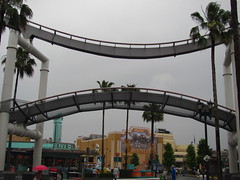



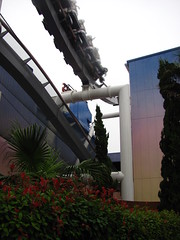
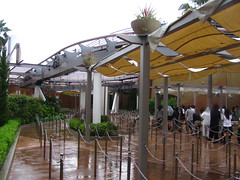





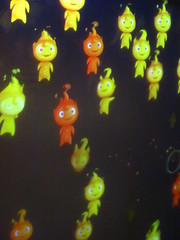







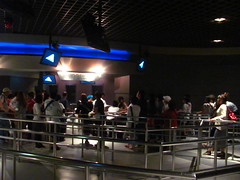

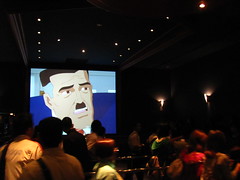







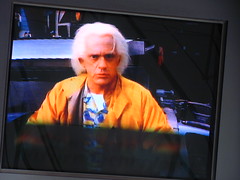












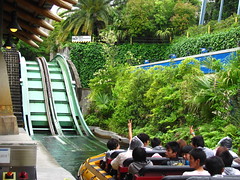





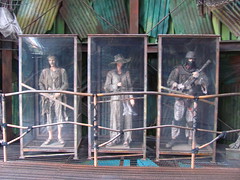






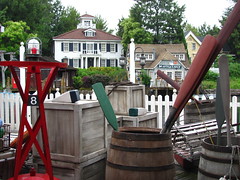













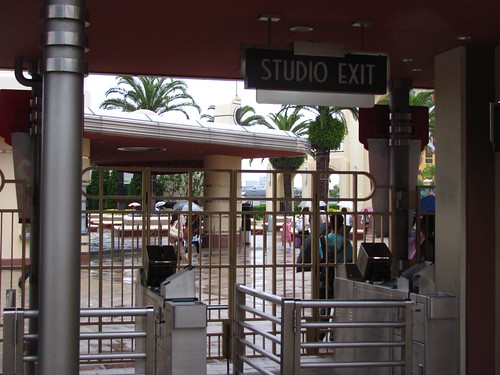





Comments